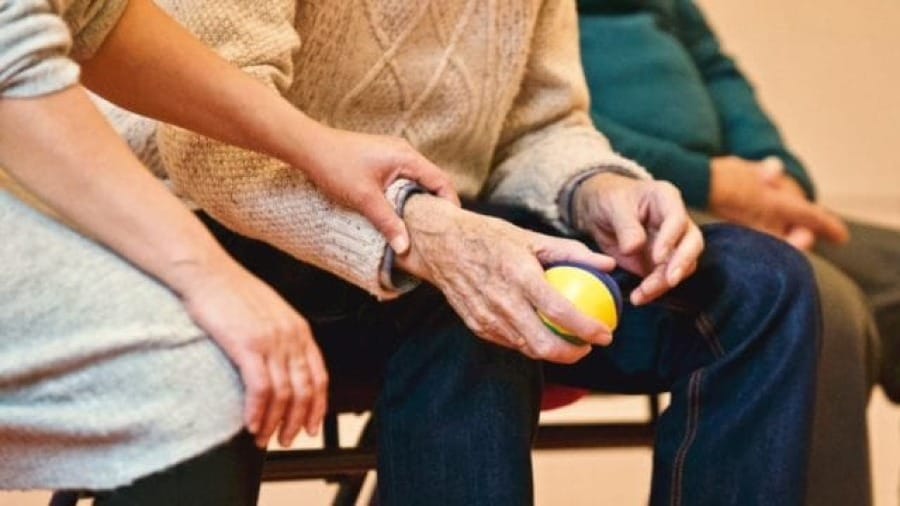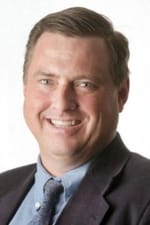South Dakota Gov. Kristi Noem on Wednesday announced a plan to aid South Dakota’s financially troubled nursing home industry by raising the rate of Medicaid payments and providing $5 million in grants to facilities that innovate.
Noem shared her ideas as part of her first budget address to both houses of the state Legislature on Wednesday in which she laid out her proposed spending plan for fiscal 2019-20. The budget proposal includes $1.7 billion in state money that rises to $4.9 billion in overall spending when federal and other revenues are added in.
Noem’s long-term care proposals, which still require legislative approval, would provide $3.8 million in new, one-time funding to give nursing homes and other Medicaid service providers a 2.5 percent increase in the rate they are reimbursed by Medicaid. Another $5.8 million new allocation would raise the reimbursement rate by another 2.5 percent as an ongoing increase. To speed up delivery of the financial assistance, those increases would take effect on April 1 rather than at the start of the fiscal year on July 1.
The governor’s speech is part of a growing momentum toward reform of nursing home funding during the ongoing legislative session in Pierre.
Three nursing homes closed over the past three years and two more are slated for closure next month, causing a loss of jobs and putting a hardship on displaced elderly and disabled residents and their families.
Another 17 former Golden Living Centers in South Dakota are facing financial challenges and are being operated by a state-approved receivership.
Industry officials say more closures are likely unless South Dakota improves its payment rate under Medicaid, which pays for the care of about 55 percent of the patients in the state’s roughly 110 nursing homes.
South Dakota has the lowest Medicaid reimbursement rate in the country, causing homes to lose $35 a day for each Medicaid patient and resulting in a $42 million overall annual funding shortfall for long-term care facilities across the state.
Randy Bury, president of the Evangelical Lutheran Good Samaritan Society, which runs 32 senior care facilities in South Dakota including several nursing homes, said more homes are sure to close if state funding doesn’t increase soon.
“It’s not a risk of more closures, it’s a certainty,” said Bury, who became president of the society after its recent merger with Sanford Health. “It’s simple math. If you’re running a business and with over half of that business you’re losing money every day, you can Band Aid and cost cut and everything, but over time you’re going to end up in the red.”
Noem also proposed creating a $5 million pool of money for so-called “Innovation Grants” that could be used by long-term care providers to develop news ways to care for people outside the traditional nursing home system. The governor also proposed spending $1 million to fund innovation among programs that provide primary and prenatal care to children.
The proposals, included within a portion of Noem’s spending plan labeled “Emergency Special Appropriations,” also included money for rural healthcare recruitment, construction of a National Guard readiness center, creation of pheasant habitat and bonus pay for wartime veterans, among others.
To fund those efforts, Noem said her budget uses money saved from underutilized human services programs and shifts it to the emergency programs, including the new money for long-term care providers and agencies that help the disabled and elderly. Additional funding would come from savings generated through Coordinated Care Agreements, in which state employees help tribal members get referred to services within the Indian Health Services that are fully covered by the federal government under Medicaid instead of the state covering half those costs.
In addition to proposing new money for nursing homes, Noem said she wants to find new models to reduce the cost of long-term care and create new options for patients.
She said she hopes to reduce the reliance on traditional nursing homes, which provide a wide range of medical services.
She suggested that efforts could be made to expand opportunities for people to stay in less-expensive assisted living centers or “community homes” and get respite care at home in order to reduce the need for long stays in nursing homes. A new tier-based system of fees could make the system more nimble and better target services, Noem said.
“These are all things that people across the state of South Dakota have been asking us for,” Noem said at a press conference after her address. “Families want to stay home longer before they go to nursing homes, they want to stay in assisted care longer before going to a nursing home.”
Noem said her hope is that the innovation grants will enable providers to use their experience and knowledge to create new delivery systems for nursing care that can save money and improve conditions for patients.
“It will be them bringing forward new ways to deliver care,” Noem said. “Nursing homes will always be an incredible apart of that care we deliver for those who have that need, but this is a time to really drive innovation in that space to care for that population.”
Patient care costs have risen
The recent nursing home closures in Bryant, Rosholt and Tripp and the pending home closures in Madison and Mobridge have shone a light on the financial vulnerability of long-term care facilities in South Dakota.
Bury acknowledged that to some people the $181 per-day cost of care for a nursing home patient might seem high, and that he thought so, too, until he visited long-term care facilities.
Bury said that years ago nursing homes were more like clubhouses with mostly able-bodied residents. Now, he said, with greater patient access to health care and home care prior to arriving at a nursing home, residents come with more frequent and intensive medical needs that raise the cost far beyond providing room and board.
“The same facility that my parents went into looked very different,” he said. “Now, you see lots of people bed-bound, limited to a wheel chair and with serious medical conditions that take constant care.”
The Certified Nursing Assistants who do much of the basic patient care in nursing homes are generally underpaid, leading to extremely high position turnover and difficulty in attracting qualified employees, said Mark Deak, executive director of the South Dakota Health Care Association.
The average wage for CNAs in South Dakota is $12.47 an hour, or about $26,000 a year, the 46th lowest in the nation.
“We think the world of the CNAs; they’re really angels,” Deak said. “They do the heavy lifting and they’re there emotionally for the residents.”
Meanwhile, the thin margin at many nursing homes has reduced the ability of ownership to improve facilities. Most nursing homes in South Dakota are 40 years old, while the average in the Midwest is only 12 years old.
Deak has been meeting with lawmakers and other officials in Pierre to convince them to support meaningful and immediate funding reform for long-term care facilities across the state.
“This is a crisis that could turn into a statewide disaster if something isn’t done,” said Deak, who was scheduled to have met with Gov. Noem to discuss the topic before her address.
Deak said awareness of the nursing home funding problems has heightened across the state recently, in part due to the closure of several homes and due to reporting by South Dakota News Watch and other media.
Deak said that he has been encouraged by recent discussions with lawmakers and state officials that some form of legislation or a funding source to boost Medicaid reimbursements will be found this session.
“There’s a lot of rumblings and it’s on folks’ minds and I’m very encouraged by appropriators I’ve spoken to,” said Deak. “My hope is that they will muster the will and identify the resources to do that so they can to help the folks who care for our elderly or disabled residents.”
South Dakota lowest in Medicaid funding
Nursing homes are essentially funded by two groups of patients, those who can pay full price on their own and lower-income patients whose care is paid for through the federal Medicaid and Medicare programs. Medicaid funding, which pays for more than half the nursing home residents in South Dakota, comes from both federal and state governments. South Dakota funds the program at the lowest per-patient rate in the nation, according to the South Dakota Association of Healthcare Organizations.
Here is how the state compares in per-day funding to neighboring states and to the daily cost of patient care.
State Per-day pay rate
North Dakota $270.71
Minnesota $246.24
Wyoming $186.89
Daily care cost $181.46
Nebraska $180.78
Montana $175.09
Iowa $174.37
South Dakota $146.38
Source: South Dakota Association of Healthcare Organizations
Several funding options available
Nursing homes and agencies that provide community services to people on Medicaid did receive a funding bump of about 2 percent over the past couple sessions, according to state Rep. Sue Peterson, R-Sioux Falls.
Peterson, who sits on the Joint Committee on Appropriations, said she is hopeful lawmakers can find a more permanent solution either by increasing funding for Medicaid providers or reducing regulations that remove flexibility from operators.
“We need to make sure we’re doing it in a magnitude so it makes a difference,” Peterson said. “It’s a matter of not only doing something about it, but also doing the right thing with reimbursement rates and regulations or a combination of both.”
Peterson said that when former Gov. Dennis Daugaard implemented a 10 percent funding reduction for all state departments shortly after taking office, Medicaid funding never rose back to pre-cut levels.
Peterson said money could be allocated by the Legislature in one of three basic ways.
A standalone bill to increase funding could be filed by a lawmaker prior to the Jan. 30 individual bill filing deadline or through a committee by Jan. 31.
A funding amendment could also be added to an existing bill throughout the session.
Peterson said a funding mechanism could also be inserted to the general spending bill that will be crafted by the Joint Appropriations Committee that then requires the approval of both chambers.
Any increase in state Medicaid funding likely would be matched at some level by the federal government, she said.
Peterson said she has studied Medicaid funding during her legislative career and supports funding reform for Medicaid service providers.
“I am keenly in tune to the problem, and very much focused on doing something about it,” she said. “I will use my position on the appropriations committee to try to right what is not right.”
If Gov. Noem indicates her support for increased funding for nursing homes and community service providers, it increases the chance money will be found, Peterson said. “If the case is made and she supports it, we know it’s more likely to be signed when it gets to her desk,” she said.
Bury said he senses that lawmakers are beginning to understand the depth of the nursing care crisis in South Dakota and he remains optimistic funding reform will take place this session to provide more financial stability for homes well into the future.
“Nobody is asking the government to come in and provide the profit margin or flip the scenario,” Bury said. “We’re simply asking the government to pay its fair share.”





